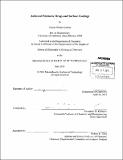| dc.contributor.advisor | Alexander M. Klibanov. | en_US |
| dc.contributor.author | Larson, Alyssa Maxine | en_US |
| dc.contributor.other | Massachusetts Institute of Technology. Department of Chemistry. | en_US |
| dc.date.accessioned | 2013-11-18T19:07:48Z | |
| dc.date.available | 2013-11-18T19:07:48Z | |
| dc.date.copyright | 2013 | en_US |
| dc.date.issued | 2013 | en_US |
| dc.identifier.uri | http://hdl.handle.net/1721.1/82315 | |
| dc.description | Thesis (Ph. D. in Biological Chemistry)--Massachusetts Institute of Technology, Dept. of Chemistry, 2013. | en_US |
| dc.description | Cataloged from PDF version of thesis. Vita. | en_US |
| dc.description | Includes bibliographical references. | en_US |
| dc.description.abstract | Viruses are a major cause of human morbidity and mortality in the world. New effective approaches to stop their spread are paramount. Herein, two approaches toward this goal are explored: (i) developing multivalent therapeutics (multiple copies of an antiviral agent covalently attached to a polymeric chain) with superior potency against their viral targets, and (ii) creating antiviral surface coatings that detoxify aqueous solutions containing various viruses on contact. By harnessing the power of multivalency we endeavored to improve the potency of influenza inhibitors, as well as resurrect the potency of two FDA-approved influenza inhibitors for which widespread drug resistance now exists. In the former direction of research, we attached multiple copies of bicyclic naphthoquinone-like monomeric inhibitors to polymeric chains. When tested against the Wuhan strain of influenza, these multivalent conjugates were up to 240- fold more potent inhibitors than their monomeric predecessors. However, this improvement in potency was strain-dependent, as two other serotypically-different influenza strains were not inhibited nearly as well by multivalent inhibitors. This strategy was also employed to restore inhibition for the adamantane class of influenza inhibitors against drug-resistant strains. The chemical modifications to the adamantane scaffold necessary for polymer attachment imposed deleterious steric constraints which resulted in poorer inhibitory effect. Even despite these drawbacks, however, the drug-polymer conjugates were up to 30-fold more potent against drug-resistant strains than their monomeric counterparts. These efforts made strides toward the ultimate goal of recovery of influenza virus inhibition for the adamantanes. To diminish transmission of viral infections, we explored the action of antimicrobial PEIbased (PEI = polyethylenimine) hydrophobic polycations against both enveloped and nonenveloped viruses. When solutions containing herpes simplex viruses (both 1 and 2) were brought in contact with NN-dodecyl,methyl-PEI coated on either polyethylene slides or latex condoms, they could be disinfected by up to 6-logs of viral titers. Our hydrophobic polycation also could be formulated into a suspension to disinfect herpes simplex virus-containing solutions, suggesting potential utility in a therapeutic modality. We also investigated whether these findings were applicable to non-enveloped viruses, namely poliovirus and rotavirus. Aqueous solutions containing them indeed could be drastically disinfected by our hydrophobic polycation-coated slides; subsequent mechanistic studies suggested that this disinfection was due to adsorption of the viruses onto the coated surfaces from solution. | en_US |
| dc.description.statementofresponsibility | by Alyssa Maxine Larson. | en_US |
| dc.format.extent | 156 p. | en_US |
| dc.language.iso | eng | en_US |
| dc.publisher | Massachusetts Institute of Technology | en_US |
| dc.rights | M.I.T. theses are protected by
copyright. They may be viewed from this source for any purpose, but
reproduction or distribution in any format is prohibited without written
permission. See provided URL for inquiries about permission. | en_US |
| dc.rights.uri | http://dspace.mit.edu/handle/1721.1/7582 | en_US |
| dc.subject | Chemistry. | en_US |
| dc.title | Antiviral polymeric drugs and surface coatings | en_US |
| dc.type | Thesis | en_US |
| dc.description.degree | Ph.D.in Biological Chemistry | en_US |
| dc.contributor.department | Massachusetts Institute of Technology. Department of Chemistry | |
| dc.identifier.oclc | 861615116 | en_US |

